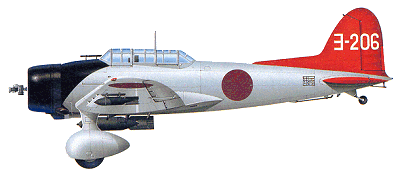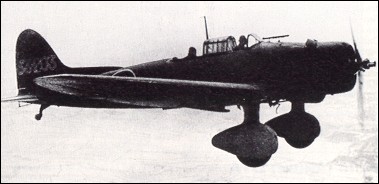|
| Although thought to be obsolescent
when Japan entered the war, the Aichi
D3A with fixed spatted landing gear
was the first Japanese aircraft to drop
bombs on American targets when aircraft
of this type took part in the great
raid on Pearl Harbor on 7 December
1941. Designed to a 1936 carrier-based
dive-bomber requirement, the prototype
was flown in January 1938 with a
530kW Nakajima Hikari 1
Radial. Production D3A1 aircraft had
slightly smaller wings and were powered
by the 745kW Mitsubishi
Kinsei 43 radial. A dorsal fin
extension considerably improved the
aircraft's manoeuvrability, although
the armament of only two forward-firing
7.7mm machine-guns,
with another of the same calibre in the
rear cockpit, was undeniably puny. After
limited land-based operations in
China and Indo-China, D3As were
flown in all major carrier actions during
the first 10 months of the war and
sank more Allied naval vessels than
any other Axis aircraft. Among British
casualties in D3A1 attacks were HMS
Hermes (the world's first carrier to be
sunk by carrier aircraft), and the cruisers
Cornwall and Dorsetshire. Heavy
losses among D3Als during and after
the Battle of the Coral Sea, however,
forced withdrawal by most of the survivors
to land bases. In 1942 the D3A2
was introduced with increased fuel
capacity and more powerful engine,
but by 1944 the aircraft were hopelessly
outclassed by American fighters; a
small number was subsequently employed
in kamikaze attacks. Production
amounted to 476 D3Als and 1,016
D3A2. The Allied reporting name was
'Val'.

| MODEL | D3A1 |
| CREW | 2 |
| ENGINE | 1 x Mitsubishi Kensei-53, 750kW |
| WEIGHTS |
| Take-off weight | 3650 kg | 8047 lb |
| Empty weight | 2408 kg | 5309 lb |
| DIMENSIONS |
| Wingspan | 14.36 m | 47 ft 1 in |
| Length | 10.20 m | 33 ft 6 in |
| Height | 3.85 m | 13 ft 8 in |
| Wing area | 34.9 m2 | 375.66 sq ft |
| PERFORMANCE |
| Max. speed | 385 km/h | 239 mph |
| Cruise speed | 295 km/h | 183 mph |
| Ceiling | 9300 m | 30500 ft |
| Range | 1500 km | 932 miles |
| ARMAMENT | 3 x 7.7mm machine-guns, 1 x 250-kg bomb, 2 x 60-kg bombs |
 | A three-view drawing (752 x 989) |
| Kristin, e-mail, 03.03.2025 20:18 The Aichi Type 99 Kanjo Bakugekiki (Kanbaku, Carrier Bomber) D3A1 was an effective Carrier Bomber--a stable bombing platform with excellent control harmony and speed control in a diving attack from medium altitudes. Because it was such a solid platform, the high standard of training in its initial aircrew made its extremely effective in its primary naval strike rôle.
The doctrine employed by Nihon Kaigun (Japanese Navy) and Nihon Kaigun Kokutai (the Japanese Naval Air Force) was also a factor, as Mick Dunne pointed out 20 years ago(!). Cohesive strikes attacking the enemy across multiple profiles dramatically increased the chances for success.
Neverthless, the Type 99 had weaknesses and drawbacks that impacted its effectiveness. Contemporaneous Carrier Bombers carried 1,000 lbs. bomb loads, including 1,000 lbs. ordnance; the Type 99 was limited to 550 lbs. payloads and 550 lbs. ordnance, which was a significant limitation--even the lowly SBC-5 Helldiver could carry a 1,000 lbs. bomb. The aircraft was more vulnerable than its contemporaries in terms of its protection, as well--it lacked any form of protection for vital components or its aircrew. The recompense for these weaknesses in ordnance and protection was superior range, but this was never an advantage NKK was able to exploit in an operationally significant way.
Like so many Japanese aircraft of the Pacific War, it seems a half-generation out of sync--an excellent introductory monoplane dive bomber of 1939 operational in 1942. Unopposed by fighters, it could still score, but the real ship killer of NKK was the Type 97 Kanjo Kogeki-Ki (Kanko, Carrier Attack Bomber). reply | | ubaTaeCJ, e-mail, 21.02.2025 19:50 20 reply | | ubaTaeCJ, e-mail, 21.02.2025 15:07 20 reply | | lxbfYeaa, e-mail, 14.03.2024 04:57 20 reply | |
| | David Green, e-mail, 20.11.2014 01:30 One thing that must be remembered is the Japanese misinformation practice. It was common practice to under rate the actual ability of their equipment. Japanese aircraft torpedoes weighed 850 kg to 1100 kg yet attack bombers have listed bomb loads of 800 kg. After reviewing the inventory of Japanese navy bombs and the performance of the D3A2 it should be able to handle a No.50 (500 kg) bomb as long as no wing bombs are carried. The use of wing bombs is normal for attacking land targets, while when attacking ships only a single center bomb would be carried. reply | | BHH, e-mail, 17.04.2014 04:43 @Mykola- Only if the enemy were Somalian pirates in fishing boats. reply | | CHUCKF*****NORRIS, e-mail, 14.03.2014 10:54 I LIKE TRAINS reply | | Klaatu83, e-mail, 22.06.2013 01:23 It has often been alleged that this aircraft was vulnerable to AA fire and Allied fighters. That was based upon the fact that the D3A, along with many other Japanese aircraft types of the period, lacked armor protection for the crews and fuel tanks, and was provided with inadequate defensive armament. reply | | Klaatu83, e-mail, 22.06.2013 01:17 Early in the war it was alleged that this airplane was a Japanese copy of the German Junkers Ju87 "Stuka", probably due to the fact that it was a dive-bomber with a spatted fixed landing gear and because of the configuration of the cockpits. However, that belief had absolutely no basis in fact, as an examination of D3As shot down at Pearl Harbor soon showed. reply | | Barry, 13.03.2012 18:26 Planes of Fame founder Ed Maloney is restoring a Val at their base in Chino Ca. This is along term project but he has said that it is the intention to get it back to flying condition. reply | | MARINER, e-mail, 29.01.2012 02:35 JAPÃO NÃO DAVA MUITO VALOR ÁS VIDAS DE SEUS PILOTOS. tanto QUE OS "VENTOS DIVINOS" ASSINAM EMBAIXO. reply | | bombardier, e-mail, 25.05.2011 11:22 The Stuka of the Pacific reply | | Mykola, 25.09.2010 10:20 I think it is so good that some navy might use it today! reply | | leo rudnicki, e-mail, 10.04.2009 03:24 It has been said that the 250kg bomb was not effective on armored capitol ships but the Imperial Navy pilots were the most highly trained and wasted fewer bombs than anyone else. The loss of the six carrier aircrews at Coral Sea and Midway was far more important than the machinery. Later pilots were not nearly as good. Dauntless carried a bigger bomb,not as far, and undertrained pilots from Midway had no effect. Well trained pilots from American carriers off Midway changed history. reply | |
| | Hiroyuki Takeuchi, e-mail, 30.01.2009 06:22 The D3A is sometimes said to have sunk more Allied ships than did any single Axis type, though I do not know what data backs this up. But it certainly achieved a number of successes in the early part of the war. Purely in terms of performance and combat effectivenss, I think the contemporary SBD was superior. reply | | Tony, e-mail, 27.01.2009 01:42 Yes, one cannot say the Val was outclassed by fighters. It was a bomber. Perhaps one could say it had become vulnerable to fighters reply |
| Mick Dunne, e-mail, 29.12.2007 04:41 Come on! All aircraft of this type were "hopelessly outclassed" by allied fighters! Like the Nell, Betty and Kate, the Val was designed as part of a very efficient WEAPONS SYSTEM that incorporated the Zero. This was a VERY good Naval Dive Bomber and it sure made its mark in the Pacific War. reply |
|
Do you have any comments?
|
| 
COMPANY
PROFILE
All the World's Rotorcraft
|









20
reply